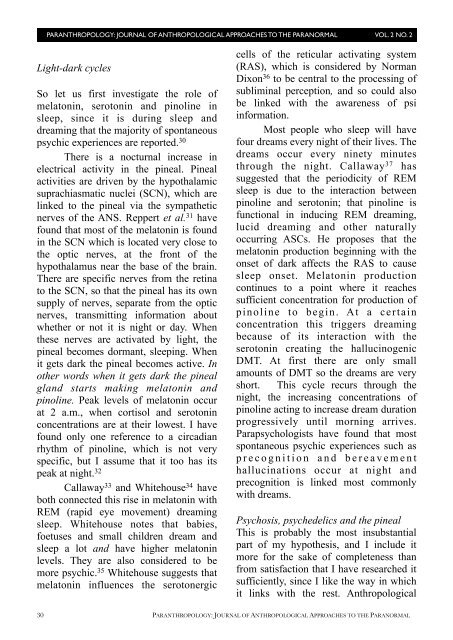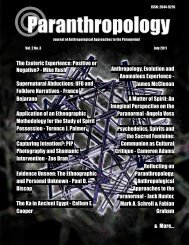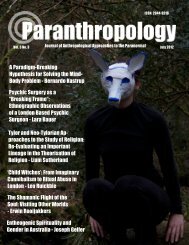Psi and Psychedelics - Paranthropology - Weebly
Psi and Psychedelics - Paranthropology - Weebly
Psi and Psychedelics - Paranthropology - Weebly
Create successful ePaper yourself
Turn your PDF publications into a flip-book with our unique Google optimized e-Paper software.
PARANTHROPOLOGY: JOURNAL OF ANTHROPOLOGICAL APPROACHES TO THE PARANORMAL VOL. 2 NO. 2<br />
Light-dark cycles<br />
So let us first investigate the role of<br />
melatonin, serotonin <strong>and</strong> pinoline in<br />
sleep, since it is during sleep <strong>and</strong><br />
dreaming that the majority of spontaneous<br />
psychic experiences are reported. 30<br />
There is a nocturnal increase in<br />
electrical activity in the pineal. Pineal<br />
activities are driven by the hypothalamic<br />
suprachiasmatic nuclei (SCN), which are<br />
linked to the pineal via the sympathetic<br />
nerves of the ANS. Reppert et al. 31 have<br />
found that most of the melatonin is found<br />
in the SCN which is located very close to<br />
the optic nerves, at the front of the<br />
hypothalamus near the base of the brain.<br />
There are specific nerves from the retina<br />
to the SCN, so that the pineal has its own<br />
supply of nerves, separate from the optic<br />
nerves, transmitting information about<br />
whether or not it is night or day. When<br />
these nerves are activated by light, the<br />
pineal becomes dormant, sleeping. When<br />
it gets dark the pineal becomes active. In<br />
other words when it gets dark the pineal<br />
gl<strong>and</strong> starts making melatonin <strong>and</strong><br />
pinoline. Peak levels of melatonin occur<br />
at 2 a.m., when cortisol <strong>and</strong> serotonin<br />
concentrations are at their lowest. I have<br />
found only one reference to a circadian<br />
rhythm of pinoline, which is not very<br />
specific, but I assume that it too has its<br />
peak at night. 32<br />
Callaway 33 <strong>and</strong> Whitehouse 34 have<br />
both connected this rise in melatonin with<br />
REM (rapid eye movement) dreaming<br />
sleep. Whitehouse notes that babies,<br />
foetuses <strong>and</strong> small children dream <strong>and</strong><br />
sleep a lot <strong>and</strong> have higher melatonin<br />
levels. They are also considered to be<br />
more psychic. 35 Whitehouse suggests that<br />
melatonin influences the serotonergic<br />
cells of the reticular activating system<br />
(RAS), which is considered by Norman<br />
Dixon 36 to be central to the processing of<br />
subliminal perception, <strong>and</strong> so could also<br />
be linked with the awareness of psi<br />
information.<br />
Most people who sleep will have<br />
four dreams every night of their lives. The<br />
dreams occur every ninety minutes<br />
through the night. Callaway 37 has<br />
suggested that the periodicity of REM<br />
sleep is due to the interaction between<br />
pinoline <strong>and</strong> serotonin; that pinoline is<br />
functional in inducing REM dreaming,<br />
lucid dreaming <strong>and</strong> other naturally<br />
occurring ASCs. He proposes that the<br />
melatonin production beginning with the<br />
onset of dark affects the RAS to cause<br />
sleep onset. Melatonin production<br />
continues to a point where it reaches<br />
sufficient concentration for production of<br />
pinoline to begin. At a certain<br />
concentration this triggers dreaming<br />
because of its interaction with the<br />
serotonin creating the hallucinogenic<br />
DMT. At first there are only small<br />
amounts of DMT so the dreams are very<br />
short. This cycle recurs through the<br />
night, the increasing concentrations of<br />
pinoline acting to increase dream duration<br />
progressively until morning arrives.<br />
Parapsychologists have found that most<br />
spontaneous psychic experiences such as<br />
precognition <strong>and</strong> bereavement<br />
hallucinations occur at night <strong>and</strong><br />
precognition is linked most commonly<br />
with dreams.<br />
Psychosis, psychedelics <strong>and</strong> the pineal<br />
This is probably the most insubstantial<br />
part of my hypothesis, <strong>and</strong> I include it<br />
more for the sake of completeness than<br />
from satisfaction that I have researched it<br />
sufficiently, since I like the way in which<br />
it links with the rest. Anthropological<br />
30 PARANTHROPOLOGY: JOURNAL OF ANTHROPOLOGICAL APPROACHES TO THE PARANORMAL




